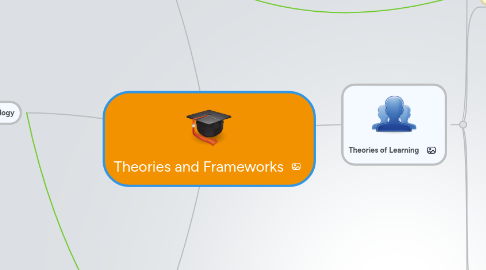
1. Theories of Technology
1.1. SCOT
1.1.1. Social Construction of Technology
1.1.2. Humans are believed to influence technology.
1.1.3. Society will choose to accept or reject new technology
1.1.4. The principle of symmetry
1.1.5. Mac vs. PC
1.1.6. Flip phone vs. touch screen
1.1.7. Walkmans vs. MP3 players
1.2. Media Ecology
1.2.1. Definitions:
1.2.1.1. Media= communication networks ie. Computers, phones, televisions.. etc
1.2.1.2. Ecology= Study of the relationships between organisms and their abiotic environment
1.2.2. Communication
1.2.2.1. How we communicate
1.2.2.2. What we communicate
1.2.3. Technology is believed to have a major impact on human society.
2. Philosophy of Teachnology
2.1. Personal view of how and when to incorporate technology into a classroom
2.2. Digital citizenship
2.3. Online etiquette
2.4. Teaching students the cause and effect of cyber bullying
2.5. Creating professional PLN's for later in life
2.6. Teaching students what is appropriate to post online and what is not
2.7. Demonstrating how technology can be used to enhance learning and be used as a way to connect with people world wide
2.8. Teachers must look at whether technology is needed for all lessons or if its just being used to modify a lesson
3. TPACK
3.1. Focus on all three knowledges and how they can effectively work together.
3.2. PCK
3.3. TCK
3.4. TPK
3.5. Important Person to Rememeber
3.5.1. Shulman
3.6. First three aspects
3.6.1. Pedagogical Knowledge
3.6.1.1. How to teach
3.6.2. Technological Knowledge
3.6.2.1. When to use technology
3.6.3. Content Knowledge
3.6.3.1. What to teach
3.7. TPACK is the intersection of content, pedagogy and technology and how each are used effectively to create a classroom focusing on not one or two but all three
4. Theories of Learning
4.1. Behaviorism
4.1.1. Trial by error
4.1.2. Teacher trying to change behavior with stimulus and response
4.1.3. Behaviourists
4.1.3.1. B.F Skinner
4.1.3.1.1. Operant Conditioning
4.1.3.2. Ivan Pavlov
4.1.3.2.1. Classical Conditioning
4.1.3.3. John B. Watson
4.2. Cognitive Load Theory
4.2.1. Working Memory
4.2.1.1. Improves with practice
4.2.1.2. Some solutions:
4.2.1.2.1. Chunking
4.2.1.2.2. Mnemonics
4.2.1.3. What our brains can manage to hold at one time.
4.2.2. Long Term Memory
4.2.2.1. Supposedly limitless
4.2.2.2. Information that has been stored in the brain to be recalled at any time.
4.2.3. ... by linking things in working memory to things that you already know and has been stored in long term memory, one should be able to remember it better.
4.2.4. Schemes
4.2.4.1. Novice- Focuses on everything they can. Remember very little.
4.2.4.2. Expert- Focus on small things then connect them to things they already know. Remember more.
4.3. Constructivism
4.3.1. How people learn through experience and reflection
4.3.2. Students become 'expert learners' through self assessments
4.3.3. Scaffolding
4.3.4. Adding to and or manipulating what you knew to fit what you have just learned
4.3.5. More creative thinking for students
4.3.6. Constructivists
4.3.6.1. Jean Piaget
4.3.6.1.1. Adaption
4.3.6.1.2. Organization
4.3.6.2. Lev Vygotsky
4.3.6.2.1. Social Development Theory
4.3.6.2.2. Culture greatly effects cognitive development
4.4. Connectivism
4.4.1. Connecting to enhance/increase knowledge.
4.4.2. Technology is a huge part
4.4.3. Examples
4.4.3.1. PLN
4.4.3.2. Twitter
4.4.3.3. Facebook
4.4.3.4. Skype
4.4.4. How we make connections
4.4.5. Use of social media
4.4.6. New information constantly being developed
4.4.7. Learning is moving from internal and individualistic to external and collaborative.
